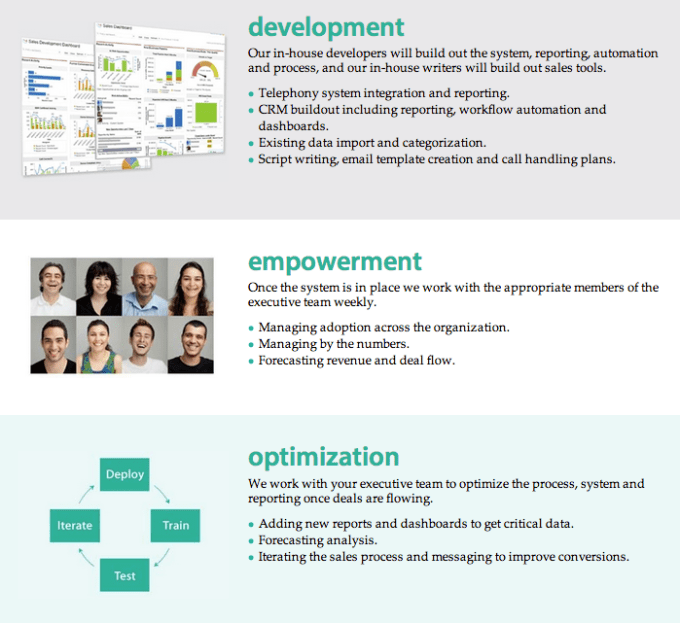If today isn’t your first day in the tech industry (or reading TechCrunch), then you’re likely familiar with the rise of the accelerator program, a phenomenon that has swept through Startup Land like wildfire over the last five years. Pioneered by early movers like Y Combinator and TechStars as part of experiments that aimed to identify the best ways to support nascent companies during those headache-inducing yet critical early stages of growth, today, the seed accelerator model is quietly marching towards ubiquity.
By helping entrepreneurs define products, identify potential customers, and by offering a nip of seed capital, co-working space, mentorship and networking opportunities — in short, immersive program packages — it’s no wonder accelerators have become one of the most popular approaches to business incubator. If accelerators get it right, the dynamic between partners and entrepreneurs is symbiotic.
In turn, you also may be aware of the explosion of interest in tools and services that cater to the growing demand not only for technical literacy within education, but among businesses looking for competent developers. Over the last two years, this new phenomenon has taken the shape of blended “learn-to-code” platforms, as these hacker academies and coding bootcamps have been rapidly proliferating across the country.
While this increasingly popular “Trade School 2.0” model differs from that of seed accelerators thanks to a greater focus on education and the individual (rather than the business), both have succeeded in developing support networks that provide framework for optimizing growth and improving potential outcomes for their “customers.”
So, ultimately, while you probably haven’t been acquainted with Upshift Partners, as the San Francisco-based startup is officially debuting for the first time today (nor its unique, hybrid model) it will seem familiar — and very much a product of the two models above.
Much like startup accelerator programs, Upshift is on a mission to provide young businesses with tools and support systems that can help them get over the hump during a critical formation stage and get to market more quickly. Furthermore, just as accelerators can help entrepreneurs define and build products and secure business-critical resources (like financing) during the early stages, Upshift’s core goal is to help entrepreneurs turn good ideas into big, sustainable businesses.
In turn, as the hacker bootcamp model has grown in popularity, it’s become clear that its success is derived largely from ways that its blended and immersive approach to education provide a better way to learn the material — in this case the core concepts behind computer science. Like accelerators, hacker schools typically offer programs of limited duration, and just as every learning experience for entrepreneurs in accelerator has a higher potential to be retained because that knowledge is offered (and, in turn acquired) if it’s relevant to helping the business grow.
Lately, the hacker school model has begun to take its first steps away from subject matter and curricula that’s exclusively focused programming and CS. The training and “student incubation” model, if you will, is now being applied to different professions. Tradecraft, for example, helps train people for UX and growth positions at high-growth startups. Startup Institute, in turn, provides students with a broader set of potential skills (as they relate to startups).
Upshift, like these hacker bootcamps for UX design and Sales training, and like the smaller cohort of accelerators that focus on incubating companies within a particular vertical, isn’t interested in helping businesses optimize broadly for growth. Instead, they’re laser-focused on helping companies get to market and scale in their area of core competency.
After all, as Upshift founder and CEO Gabriel Luna-Ostaseski says, entrepreneurs face enough challenges and uncertainties in building their businesses. They don’t need Upshift offering half-assed advice about, say, recruiting engineers. That’s why Upshift is sticking to sales.
By enlisting the startup’s support, businesses can remove sales from the top of their list of uncertainties. To increase the potential value it can bring to each business, Upshift partners with only two or three partners at a time, eschewing advice to focusing on developing solutions to their partners’ sales problems.
Instead, Upshift spends a few months doing due diligence on prospective partners, assessing, designing, engineering, testing and then optimizing customer acquisition channels. Once the system is tested and ready to wear, then Upshift will work with business’ sales teams to show them how to get the most out of their new sales framework, as well as how to effectively use those tools to take operations to the next level.

At this point in the process, depending on how the company has progressed with its new sales infrastructure, Upshift’s approach shares another potential similarity with the accelerator seed fund model. Again, once everything is in place, if the Upshift founder agrees that there’s real potential, they will invest between $25K to $100K of their own money to add more fuel to its engines.
Targeting mid-sized startups who are ready to invest in building a big sales team, but either aren’t sure where to begin or know that, with the resources they could dedicate, they could afford it, though it might take more time than they potentially have to give. Assuming the Upshift founders, having built sales teams of 100-plus before, are keeping things (comparatively) affordable and wouldn’t price out customers that might be on the fence about whether to invest the capital and resources.
Of course, at this point, a logical question from the perspective of a startup and potential Upshift partner would be, while that sounds good on the surface, how can I trust that, if I allocate the spend, I’ll get results? First of all, if anyone ever offers a “guarantee” in response to that question, walk away. That said, Upshift is hoping to get potential customers 99 percent of the way there, for starters, in the amount of time it spends doing due diligence.
If the founders can get comfortable on their own diligence, enough to add the company to their portfolio, then they’re essentially agreeing to spend weeks planning and designing your new sales funnel. Founder Luna-Ostaseski tells us that, as part of the analysis Upshift does of its new portfolio company, it will make a deep-dive into the company’s marketing and sales operations to understand where they need to optimize.
They spend time researching the ins and outs of the sales infrastructure, interviewing customers to get a more complete picture and understand key values, before reviewing the company’s current customer acquisition systems, processes and teams. Then, once it has a full picture of how the business defines and understands both itself and its customer, it begins working with the business to develop short-term and long-term sales strategies and doing in-depth sales modeling through ROI analysis, staffing expectations, targets, and so on.
From there, Upshift designs its system, customizing to the company’s particular needs, integrating with CRM platforms of choice, sales process automation and design, telephone script and email template design, in-depth reporting and executive dashboards. Once Upshift’s engineering team completes the development, the founder works with the team to get them on-boarded and, longer-term, offer to meet with executives weekly, help manage expectations and make optimizations to the system.
Again, while that gives one a clearer picture of how Upshift approaches the sales optimization process, the question remains about the founder. How can you be sure they are the sales experts they say there?
 Ostaseski says that, having been a founder, operator, advisor and angel investor, his perspective, recommendations, and strategizing is informed by multiple perspectives, and likely more than the average investor. His experience also makes him both “serial” founder, meaning that it’s not his first rodeo. In turn, he developed the idea for Upshift after coming to the conclusion that there just isn’t an obvious or magic formula that works every time when it comes to optimizing sales. Each company, each customer and each dynamic is different.
Ostaseski says that, having been a founder, operator, advisor and angel investor, his perspective, recommendations, and strategizing is informed by multiple perspectives, and likely more than the average investor. His experience also makes him both “serial” founder, meaning that it’s not his first rodeo. In turn, he developed the idea for Upshift after coming to the conclusion that there just isn’t an obvious or magic formula that works every time when it comes to optimizing sales. Each company, each customer and each dynamic is different.
Furthermore, at his friends companies and with colleagues he watched as many struggled with integration and UX friction, taking them sometimes years to put systems in place. So, deciding that after the necessary development process, he could help reduce setup time from years down to months and help businesses improve conversion rates and acquisition through a hands-on, high-touch and strategic process.
At which point one might be tempted to say that those — while key to offering more value to your customers’ experience and potentially increasing loyalty — are usually not the ingredients for seamless scaling. But Luna-Ostaseski helped lead one of these companies, CalFinder Group, from bootstrap to $20 million in sales, and has had success building sales teams of between 20 and 100 as well.
Because the firm is just launching today, it doesn’t yet have its portfolio filled out and is still vetting prospects. So while there aren’t any big, stand-out victories to point to yet under the Upshift masthead, Luna-Ostaseski spent time consulting with companies in a similar vein before deciding to turn his proprietary sales knowledge into a business.
One of the companies he worked with was Thumbtack, the marketplace for local services. Co-founder Jonathan Swanson said of the company’s situation at the time, “We had zero sales experience at Thumbtack,” and were in the same position many companies find themselves in — they’re willing to spend the money to hire a CMO and invest in that side of the business, but are hesitant to do that without really knowing what they’re looking for. As a result, Thumbtack turned to Gabe because of his experience scaling similarly-sized sales teams.
“Most of our work with consultants over the years hasn’t been successful,” Swanson continued, so their expectations were low. Luna-Ostaseski was able to pull it off, working within the company’s framework to optimize the existing team and build on it, “creating a productive sales team from square one in just a few months,” Swanson said, a process which “would have taken [Thumbtack] at least twice as long to do by ourselves.”
For more, find Upshift at home here.
